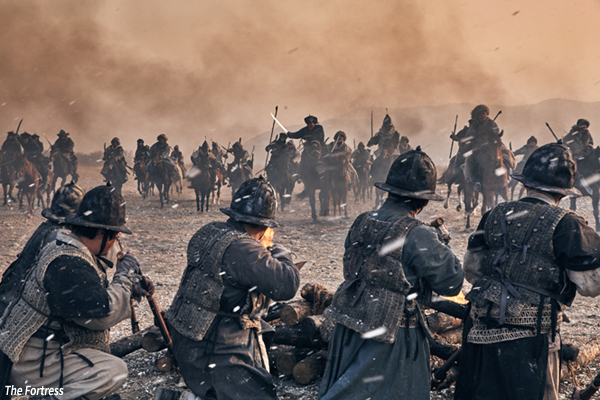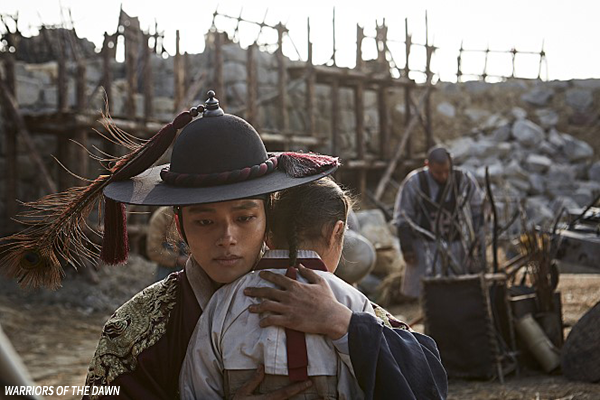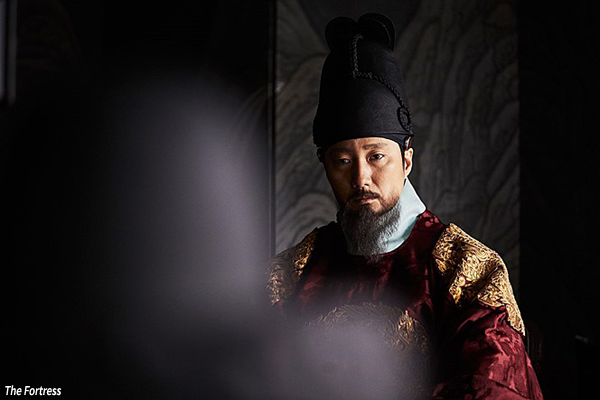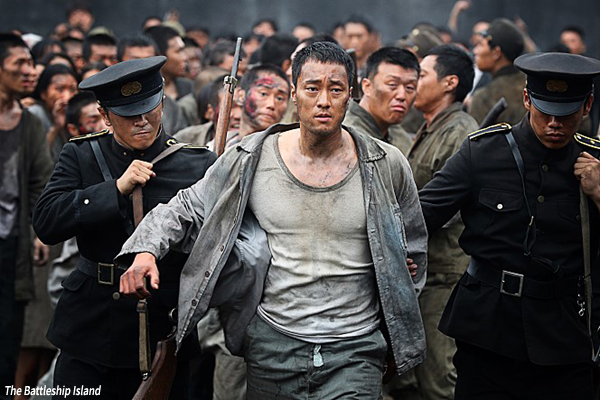hankyoreh
Links to other country sites 다른 나라 사이트 링크
[Cine feature] The True History Behind the Blockbuster-Scale Costume Dramas of 2017

There are quite a number of Korean films based on historical facts being released in 2017 and so far the audience’s response to these films, which present both the impact of ‘true facts’ and the relatable qualities of ‘history’, have been enthusiastic. We have put together in chronological order four films based on true stories taken from major historical events, often-quoted in Korean cinema yet too extraordinary to be believed as true.
WARRIORS OF THE DAWN, The Japanese Invasion of Korea in 1592
When the Japanese military launched an attack on Joseon Dynasty era Korea in 1592, King Seonjo placed temporary control of the war cabinet in the hands of Crown Prince Gwanghae and fled north to the border of Ming China. Prince Gwanghae recruits a volunteer loyal troop and heads for the Gangye area to fight against the Japanese, while appointing proxy soldiers as his guards. These so called ‘proxy soldiers’ were in most cases men from lower social classes that were paid to serve a military term in another person’s name to make ends meet. The proxy soldiers, each for their own personal reasons, join the journey, making a significant contribution by safely escorting the Prince to his destination. The entire group falls into danger when they are ambushed by an unidentified assassin while the Japanese army is still in pursuit of them.
Filmmaker Chung Yoon-chul’s WARRIORS OF THE DAWN, which spans from the beginning of the Japanese Invasion to the spring of 1593, focuses on the specific subject matter of ‘proxy soldiers’ which has never been dealt with in any costume drama to date. The film stems from the assumption that these proxy soldiers may have marked the start of the loyal troops during the Joseon Dynasty. According to historical records, Prince Gwanghae travelled throughout the country with his war cabinet to recruit loyal troop soldiers. A few interesting tips about the film is the way it highlights these particular soldiers and Prince Gwanghae who holds the key to the Royal Court’s fate in his father, King Seonjo’s place. Prince Gwanghae has been depicted in many ways, from tyrant to benevolent ruler in both films and TV dramas, but none have focused on the leadership he displayed during the Japanese Invasion of 1592. Filmmaker Chung Yoon-chul explains that he made this film, which shows how the ruler of a nation and his people come to understand each other, with the purpose of exploring the idea of ‘understanding or communicating’ which has become one of the most sought out key words in recent times.
The Fortress, the Manchu War of 1636
In 1636, during the 14th year of King Injo’s reign, the Manchu Qing army invaded Joseon. Fleeing from the cavalry-fronted Qing army who quickly advanced to the capital city of Hanyang, the king and his royal court sought refuge at the Namhan Mountain Fortress. Unfortunately, the king and his entourage were surrounded by the Qing army and isolated inside the fortress. The bitter cold weather, hunger and the enemy’s humiliating demands for them to surrender continued while the king and his court officials fiercely debated on a course of action that would determine the future of Joseon. The ‘doves’ or ‘soft-liners’, led by Choi Myeong-gil (Lee Byung-hun), supported the idea of bearing the humiliation for now and planning for the future by making peace with the Qing Dynasty, while the ‘hawks’ or ‘hard-liners’, led by Kim Sang-heon (Kim Yun-seok), contended to fight to the end and defend their cause.
The Fortress deals with King Injo and his royal court’s 47-days refuge at Namhan Mountain Fortress and is based on writer KIM Hoon’s bestselling novel of the same title. The original story, which focuses on the visualization of concepts such as ‘terrifying cold weather’ and ‘the faint scent of spring coming’, presents a striking depiction of conflict and union between the characters. The book went on to sell 700 thousand copies and 100 prints. Filmmaker Hwang Dong-hyuk who proved his talent in genre films Silenced (2011) and Miss Granny (2014) decided to adapt the novel into film after reading it “in hopes that it could inspire people to contemplate the various issues of contemporary society and its solutions by looking back at the dilemmas and decisions that our ancestors made during that particular time in history”. To tackle the challenges of re-enacting historical facts and visually interpreting the novel’s literary phrases, veteran actors including Lee Byun-hun, Kim Yun-seok, Park Hae-il and Ko Soo were cast while focusing on production design, costume and make-up to make the film look as realistic as possible.
Anarchist from Colony, the Great Kanto Earthquake and the massacre of Joseon Koreans in 1923
A false rumor was spread after the 1923 Great Kanto Earthquake. Claims were made that Joseon Koreans were poisoning the wells, taking advantage of the confusion after the quake by setting fire to state-run facilities and attempting to bomb key Japanese figures. Subsequently 6,000 falsely accused Joseon Koreans were murdered by Japanese mobs. The Japanese cabinet, trying to cover-up the massacre and turn the public’s attention away from the case, decided to arrest young Joseon Korean Park Yeol (Lee Je-hoon) who is a fervent anti-Japanese activist. PARK, who was still in high school when he crossed over into Japan in 1919 during the March 1st Independence Movement, forms his own anarchist group ‘Futeisha: The Outlaws’ to conduct anarchist activities in Japan. Realizing Japan’s scheme to conspire against him, Park confesses the plot to kill the Crown Prince by bombing with his comrade and lover, Kaneko Fumiko (Choi Hee-seo). A historic trial takes place and PARK Yeol is sentenced to death.
‘This film is strictly based on historical research’, ‘All characters are real historical figures’. These phrases which appear at the beginning of the film indicate the extensive efforts the film put into historical research. Filmmaker Lee Joon-ik, while preparing for the film The Anarchists (2000) which he served as producer 17 years ago, became interested in historical figures who were unknown to the public. Among them he decided to make a film highlighting the life and convictions of Park Yeol who passionately questioned and resisted the Japanese cabinet. Lee Joon-ik has already displayed his talent in costume dramas through films such as The Throne (2015) and DONGJU: The Portrait of a Poet (2016). Anarchist from Colony sets itself apart in its depiction of the Japanese occupation as it tells the story of Pak Yeol and his companion Fumiko.
The Battleship Island, forced labor of Joseon Koreans in 1945
The Japanese Government, using the 1938 ‘National Mobilization Law’, drafted young Joseon Koreans and forced them into labor. Among the many, some were taken to Hashima Island, also known as ‘Battleship Island’, which was additionally regarded as ‘hell’s island’ or ‘prison island’. The Joseon Koreans drafted against their will were sent to coal mines where they were forced to spend more than 12 hours in undersea mines reaching up to 1 km in depth with temperatures of 45 degrees Celsius. Within such a horrendous environment, Joseon Koreans suffered from mining accidents and malnutrition. When it became clear that Japan was losing the war in 1945, there were Joseon Koreans who risked their lives to escape Battleship Island.
In 2012, when filmmaker Ryoo Seung-wan set eyes on a photo of Battleship Island which seemed like a gigantic prison, he thought of an escape story. His desire to recreate the horrific history of Battleship Island for many people to see had him embark on a long-term mission to turn this story into a film. On July 5th, 2015, the island was recognized as a symbol of modernization and the industrial revolution and approved as a UNESCO World Heritage site when in fact Japan had actually erased its history of the forced labor of Joseon Koreans. Two years later in July, 2017, with the addition of cinematic imagination, the history of Hashima Island came to life through the film, The Battleship Island.
by KIM Su-bin, Cine21 reporter
- See more at:
These contents were reproduced with the permission of Kofic, which holds all copyright.
Editorial・opinion
![[Column] Park Geun-hye déjà vu in Yoon Suk-yeol [Column] Park Geun-hye déjà vu in Yoon Suk-yeol](https://flexible.img.hani.co.kr/flexible/normal/500/300/imgdb/original/2024/0424/651713945113788.jpg) [Column] Park Geun-hye déjà vu in Yoon Suk-yeol
[Column] Park Geun-hye déjà vu in Yoon Suk-yeol![[Editorial] New weight of N. Korea’s nuclear threats makes dialogue all the more urgent [Editorial] New weight of N. Korea’s nuclear threats makes dialogue all the more urgent](https://flexible.img.hani.co.kr/flexible/normal/500/300/imgdb/original/2024/0424/7317139454662664.jpg) [Editorial] New weight of N. Korea’s nuclear threats makes dialogue all the more urgent
[Editorial] New weight of N. Korea’s nuclear threats makes dialogue all the more urgent- [Guest essay] The real reason Korea’s new right wants to dub Rhee a founding father
- [Column] ‘Choson’: Is it time we start referring to N. Korea in its own terms?
- [Editorial] Japan’s rewriting of history with Korea has gone too far
- [Column] The president’s questionable capacity for dialogue
- [Column] Are chaebol firms just pizza pies for families to divvy up as they please?
- [Column] Has Korea, too, crossed the Rubicon on China?
- [Correspondent’s column] In Japan’s alliance with US, echoes of its past alliances with UK
- [Editorial] Does Yoon think the Korean public is wrong?
Most viewed articles
- 1[Column] Park Geun-hye déjà vu in Yoon Suk-yeol
- 2Why Korea shouldn’t welcome Japan’s newly beefed up defense cooperation with US
- 3[Guest essay] The real reason Korea’s new right wants to dub Rhee a founding father
- 4Will NewJeans end up collateral damage in internal feud at K-pop juggernaut Hybe?
- 5Thursday to mark start of resignations by senior doctors amid standoff with government
- 6N. Korean hackers breached 10 defense contractors in South for months, police say
- 7[Column] ‘Choson’: Is it time we start referring to N. Korea in its own terms?
- 8Kim Jong-un expressed ‘satisfaction’ with nuclear counterstrike drill directed at South
- 9[Editorial] New weight of N. Korea’s nuclear threats makes dialogue all the more urgent
- 10Senior doctors cut hours, prepare to resign as government refuses to scrap medical reform plan